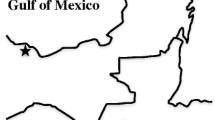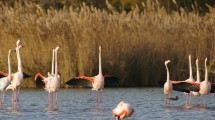Abstract
We used multiple regression, path analysis and non-parametric selection surface visualisation to investigate natural and sexual selection and, in addition, cross-sectional female choice statistics to analyse female choice in a wild population of the field cricket Gryllus campestris L. in central Germany. Adults (167 males, 75 females) were individually marked and followed daily over the entire adult stage. Two morphological traits (pronotum width, body condition) and two behavioural traits (burrow occupation time, daily displacement) were measured for each male and used in selection analyses. Individuals mated multiply and male mating success was strongly right skewed with less than 6% of the population achieving 50% of the copulations. In males, analysis of natural selection in terms of lifespan revealed positive directional selection on burrow occupation time and stabilising selection on daily displacement. Analysis of sexual selection in term of mating success showed positive directional selection on pronotum width and lifespan. Path analysis confirmed the close association between natural and sexual selection and illustrated indirect effects of the behavioural variables on mating success via their effect on lifespan. Multiple regression analysis further indicated positive quadratic (disruptive) sexual selection on lifespan but the non-parametric cubic spline regression showed this to be an artefact of the quadratic approach. In fact, lifespan was under “threshold selection” i.e. it was not under selection below a threshold and under positive directional sexual selection above the threshold. A positive correlational selection gradient between lifespan and body condition revealed that a high body condition is advantageous among long-lived males. Female choice statistics showed that females chose large and heavy males in the beginning of the season only and that choosiness decreases with increasing distance to potential alternative mates. Our findings highlight the benefits of combining several analytical methods to uncover selection patterns and to avoid misinterpretations based on single methods.





Similar content being viewed by others
References
Arnold SJ, Wade MJ (1984a) On the measurement of natural and sexual selection: applications. Evolution 38:720–734
Arnold SJ, Wade MJ (1984b) On the measurement of natural and sexual selection: theory. Evolution 38:709–719
Bateman PW, Gilson LN, Ferguson JWH (2001) Male size and sequential mate preference in the cricket Gryllus bimaculatus. Anim Behav 61:631–637
Benjamini Y, Hochberg Y (1995) Controlling the false discovery rate—a practical and powerful approach to multiple testing. J R Stat Soc B 57:289–300
Bentsen CL, Hunt J, Jennions MD, Brooks R (2006) Complex multivariate sexual selection on male acoustic signaling in a wild population of Teleogryllus commodus. Am Nat 167:E102–E116
Blows MW, Brooks R (2003) Measuring nonlinear selection. Am Nat 162:815–820
Brodie ED, Janzen FJ (1996) On the assignment of fitness values in statistical analyses of selection. Evolution 50:437–442
Brodie ED, Moore AJ, Janzen FJ (1995) Visualizing and quantifying natural selection. Trends Ecol Evol 10:313–318
Cade WH (1981) Field cricket spacing, and the phonotaxis of crickets and parasitoid flies to clumped and isolated cricket songs. Zeitschrift für Tierpsychologie 55:365–375
Conner JK (2001) How strong is natural selection? Trends Ecol Evol 16:215
Gray DA (1999) Intrinsic factors affecting female choice in house crickets: time cost, female age, nutritional condition, body size, and size-relative reproductive investment. J Insect Behav 12:691–700
Green PJ, Silverman BW (1994) Nonparametric regression and generalized linear models. Chapman and Hall, London
Gwynne DT (2001) Katydids and bush-crickets: reproductive behavior and evolution of the Tettigoniidae. Cornell University Press, New York
Hedrick AV, Dill LM (1993) Mate choice by female crickets is influenced by predation risk. Anim Behav 46:193–196
Hereford J, Hansen TF, Houle D (2004) Comparing strengths of directional selection: how strong is strong? Evolution 58:2133–2143
Hockham LR, Vahed K (1997) The function of mate guarding in a field cricket (Orthoptera: Gryllidae; Teleogryllus natalensis Otte and Cade). J Insect Behav 10:247–256
Hoekstra HE, Hoekstra JM, Berrigan D, Vignieri SN, Hoang A, Hill CE, Beerli P, Kingsolver JG (2001) Strength and tempo of directional selection in the wild. Proc Natl Acad Sci USA 98:9157–9160
Huber F, Moore TE, Loher WE (1989) Cricket behavior and neurobiology. Cornell University Press, Ithaca
Hunt J, Brooks R, Jennions MD, Smith MJ, Bentsen CL, Bussiere LF (2004) High-quality male field crickets invest heavily in sexual display but die young. Nature 432:1024–1027
Kiflawi M, Gray DA (2000) Size-dependent response to conspecific mating calls by male crickets. Proc R Soc Lond B 267:2157–2161
Kingsolver JG, Pfennig DW (2007) Patterns and power of phenotypic selection in nature. Bioscience 57:561–572
Kingsolver JG, Hoekstra HE, Hoekstra JM, Berrigan D, Vignieri SN, Hill CE, Hoang A, Gibert P, Beerli P (2001) The strength of phenotypic selection in natural populations. Am Nat 157:245–261
Kline RB (2004) Principles and practice of structural equation modelling. Guilford Press, New York
Köhler G, Reinhardt K (1992) Beitrag zur Kenntnis der Feldgrille (Gryllus campestris L.) in Thüringen. Articulata 7:63–76
Kokko H, Mappes J (2005) Sexual selection when fertilization is not guaranteed. Evolution 59:1876–1885
Lande R, Arnold SJ (1983) The measurement of selection on correlated characters. Evolution 37:1210–1226
Mitchell-Olds T, Bergelson J (1990) Statistical genetics of an annual plant, Impatiens capensis. II. Natural selection. Genetics 124:417–421
Mitchell-Olds T, Shaw RG (1987) Regression analysis of natural selection: statistical inference and biological interpretation. Evolution 41:1149–1161
Petraitis PS, Dunham AE, Niewiarowski PH (1996) Inferring multiple causality: the limitations of path analysis. Funct Ecol 10:421–431
Phillips PC, Arnold SJ (1989) Visualizing multivariate selection. Evolution 43:1209–1222
Popov AV (1975) Acoustic behaviour and migrations of field crickets Gryllus campestris (in russian). Zoologichesky Zhurnal 54:1803–1809
Popov AV, Shuvalov VF (1977) Phonotactic behavior of crickets. J Comp Physiol A 119:111–126
Prosser MR, Murray A-M, Cade WH (1997) The influence of female age on phonotaxis during single and multiple song presentations in the field cricket, Gryllus integer (Orthoptera: Gryllidae). J Insect Behav 10:437–449
R Development Core Team (2006) R—a language and environment for statistical computing. R Foundation for Statistical Computing, Vienna
Ritz MS (2000) Verhalten der Männchen in einer Wildpopulation der Feldgrille (Gryllus campestris L.). Articulata 15:87–98
Ritz MS, Köhler G (2007) Male behaviour over the season in a wild population of the field cricket Gryllus campestris L. Ecol Entomol 32:384–392
Ritz MS, Sakaluk SK (2002) The role of the male’s cerci in copulation and mate guarding in decorated crickets (Gryllodes sigillatus). J Zool 257:519–523
Rost R, Honegger HW (1987) The timing of premating and mating behavior in a field population of the cricket Gryllus campestris L. Behav Ecol Sociobiol 21:279–289
Ryder JJ, Siva-Jothy MT (2000) Male calling song provides a reliable signal of immune function in a cricket. Proc R Soc Lond B 267:1171–1175
Sakaluk SK (1991) Post-copulatory mate guarding in decorated crickets. Anim Behav 41:207–216
Sakaluk SK, Cade WH (1983) The adaptive significance of female multiple matings in house and field crickets. In: Gwyne DT, Morris GK (eds) Orthopteran mating systems, sexual competition in a diverse group of insects. Westview Press, Boulder, pp 319–336
Sakaluk SK, Schaus JM, Eggert A-K, Snedden WA, Brady PL (2002) Polyandry and fitness of offspring reared under varying nutritional stress in decorated crickets. Evolution 56:1999–2007
Scheiner SM, Mitchell RJ, Callahan HS (2000) Using path analysis to measure natural selection. J Evol Biol 13:423–433
Schluter D (1988) Estimating the form of natural selection on a quantitative trait. Evolution 42:849–861
Schluter D, Nychka D (1994) Exploring fitness surfaces. Am Nat 143:597–616
Shipley B (2000) Cause and correlation in biology: a user’s guide to path analysis, structural equations and causal inference. Cambridge University Press, Cambridge
Shuvalov VF, Popov AV (1973) The importance of the calling song rhythmic pattern of males of the genus Gryllus for phonotaxis of females. Zoologichesky Zhurnal 52:1179–1185
Simmons LW (1987) Sperm competition as a mechanism of female choice in the field cricket, Gryllus bimaculatus (De Geer). Behav Ecol Sociobiol 21:197–202
Simmons LW (1988a) The calling song of the field cricket, Gryllus bimaculatus (De Geer): constraints on transmission and its role in intermale competition and female choice. Anim Behav 36:380–394
Simmons LW (1988b) Male size, mating potential and lifetime reproductive success in the field cricket, Gryllus bimaculatus (De Geer). Anim Behav 36:372–379
Simmons LW (1992) Sexual selection and body size in a natural population of the field cricket, Gryllus campestris (L.). Journal of Orthoptera Research 1:12–13
Simmons LW (1995) Correlates of male quality in the field cricket, Gryllus campestris L.: age, size, and symmetry determine pairing success in field populations. Behav Ecol 6:376–381
Simmons LW, Ritchie MG (1996) Symmetry in the songs of crickets. Proc R Soc Lond B 263:1308–1311
Simmons LW, Zuk M (1992) Variability in call structure and pairing success of male field crickets, Gryllus bimaculatus: the effect of age, size and parasite load. Anim Behav 44:1145–1152
Stinchcombe JR, Agrawal AF, Hohenlohe PA, Arnold SJ, Blows MW (2008) Estimating nonlinear selection gradients using quadratic regression coefficients: Double or nothing? Evolution 62:2435–2440
Tregenza T, Wedell N (1998) Benefits of multiple mates in the cricket Gryllus bimaculatus. Evolution 52:1726–1730
Verhoeven KJF, Simonsen KL, McIntyre LM (2005) Implementing false discovery rate control: increasing your power. Oikos 108:643–647
Vieth E (1989) Fitting piecewise linear regression functions to biological responses. J Appl Physiol 67:390–396
Wagner WEJ, Hoback WW (1999) Nutritional effects on male calling behaviour in the variable field cricket. Anim Behav 57:89–95
Wright S (1920) The relative importance of heredity and environment in determining the piebald pattern of guinea pigs. Proc Natl Acad Sci USA 6:320–332
Zar JH (1999) Biostatistical analysis, 4th edn. Prentice-Hall, New Jersey
Zippelius H-M (1949) Die Paarungsbiologie einiger Orthopteren-Arten. Zeitschrift für Tierpsychologie 6:372–390
Zuk M (1987) Variability in attractiveness of male field crickets (Orthoptera: Gryllidae) to females. Anim Behav 35:1240–1248
Zuk M (1988) Parasite load, body size, and age of wild-caught male field crickets (Orthoptera: Gryllidae): effects on sexual selection. Evolution 42:969–976
Acknowledgments
K. Reinhardt and an anonymous referee gave us the final push to conduct the detailed selection analysis on our data set. S. K. Sakaluk, R. Brooks and three anonymous referees made helpful comments on the manuscript.
Author information
Authors and Affiliations
Corresponding author
Rights and permissions
About this article
Cite this article
Ritz, M.S., Köhler, G. Natural and sexual selection on male behaviour and morphology, and female choice in a wild field cricket population: spatial, temporal and analytical components. Evol Ecol 24, 985–1001 (2010). https://doi.org/10.1007/s10682-009-9328-y
Received:
Accepted:
Published:
Issue Date:
DOI: https://doi.org/10.1007/s10682-009-9328-y




